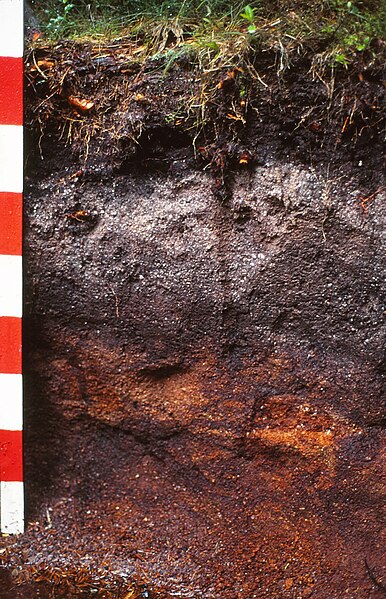In soil science, podzols are the typical soils of coniferous or boreal forests and also the typical soils of eucalypt forests and heathlands in southern Australia. In Western Europe, podzols develop on heathland, which is often a construct of human interference through grazing and burning. In some British moorlands with podzolic soils, cambisols are preserved under Bronze Age barrows.
The picture is of a stagnic podzol in upland Wales, and shows the typical sequence of organic topsoil with leached grey-white subsoil with iron-rich horizon below. This example has two weak ironpans.
A Podzol with a characteristic eluvial (bleached, ash-colored) horizon and intensely coloured illuvial horizons. The photo was taken in the Feldberg area, Southern Black Forest, Germany.
Taiga, also known as boreal forest or snow forest, is a biome characterized by coniferous forests consisting mostly of pines, spruces, and larches. The taiga or boreal forest is the world's largest land biome. In North America, it covers most of inland Canada, Alaska, and parts of the northern contiguous United States. In Eurasia, it covers most of Sweden, Finland, much of Russia from Karelia in the west to the Pacific Ocean, much of Norway and Estonia, some of the Scottish Highlands, some lowland/coastal areas of Iceland, and areas of northern Kazakhstan, northern Mongolia, and northern Japan.
Jack London Lake in Kolyma, Russia
The Adirondack Mountains of Upstate New York form the southernmost part of the Eastern forest-boreal transition ecoregion, constituting part of the world’s taiga biome.
White spruce taiga in the Alaska Range, Alaska, United States
Siberian taiga






